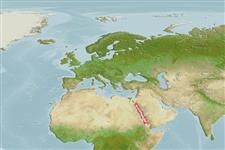Common names from other countries
>
Eupercaria/misc (Various families in series Eupercaria) >
Scaridae (Parrotfishes) > Scarinae
Etymology: Cetoscarus: Greek, ketos = a marine monster, whale + Greek, skaros = a fish cited by ancient writers; a parrot fish (Ref. 45335).
More on author: Rüppell.
Issue
This species is endemic to the Red Sea (Ref. 54980:447, species treatment in prep). Correction of data other than distribution is in progress (information transfer to C. ocellatus of the Indo-Pacific).
Environment: milieu / climate zone / depth range / distribution range
Ökologie
seewasser riff-verbunden; tiefenbereich 1 - 30 m (Ref. 27115). Tropical; 24°C - 28°C (Ref. 27115); 33°N - 12°N, 32°E - 44°E
Western Indian Ocean: Red Sea endemic.
Size / Gewicht / Alter
Maturity: Lm ? range ? - ? cm
Max length : 50.0 cm SL Männchen/unbestimmt; (Ref. 115947); max. veröff. Gewicht: 2.4 kg (Ref. 125599)
Benthic grazer of algae (Ref. 3488). Caught with nets and other types of artisanal gear.
Life cycle and mating behavior
Geschlechtsreife | Fortpflanzung | Ablaichen | Eier | Fecundity | Larven
Oviparous, distinct pairing during breeding (Ref. 205).
Choat, J.H., B. Russell, K.D. Clements, L.A. Rocha, R. Myers, M.E. Lazuardi, A. Muljadi, S. Pardede and P. Rahardjo, 2012. Cetoscarus bicolor. The IUCN Red List of Threatened Species 2012:e.T190690A17793737. Downloaded on 03 August 2017. (Ref. 115947)
IUCN Rote Liste Status (Ref. 130435)
CITES (Ref. 128078)
Not Evaluated
Bedrohung für Menschen
Harmless
Nutzung durch Menschen
Fischereien: kommerziell; Aquarium: Kommerziell
Mehr Information
ReferenzenAquakulturAquakultur ProfilZuchtlinienGenetikElectrophoresesVererbbarkeitKrankheitenVerarbeitungMass conversion
Tools
Zusatzinformationen
Download XML
Internet Quellen
Estimates based on models
Preferred temperature (Ref.
115969): 24.9 - 29.1, mean 27.9 (based on 1232 cells).
Phylogenetic diversity index (Ref.
82804): PD
50 = 0.7500 [Uniqueness, from 0.5 = low to 2.0 = high].
Bayesian length-weight: a=0.01202 (0.00687 - 0.02104), b=3.02 (2.87 - 3.17), in cm Total Length, based on LWR estimates for this species & (Sub)family-body (Ref.
93245).
Trophic level (Ref.
69278): 2.0 ±0.00 se; based on food items.
Widerstandsfähigkeit (Ref.
120179): niedrig, Verdopplung der Population dauert 4,5 - 14 Jahre. (tm=5; K=0.255; tmax=21).
Fishing Vulnerability (Ref.
59153): Low to moderate vulnerability (34 of 100).
